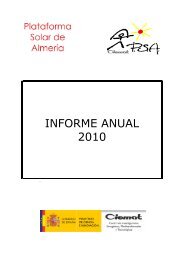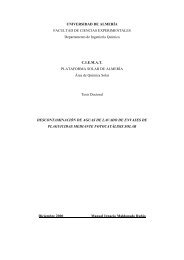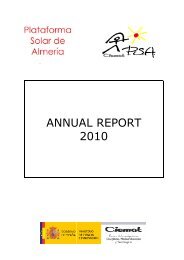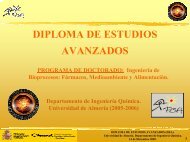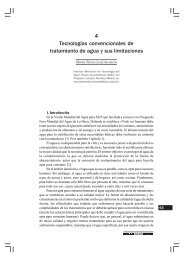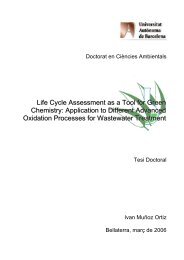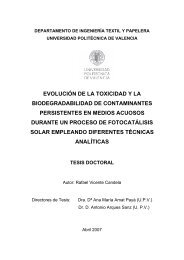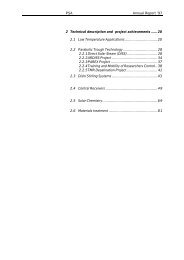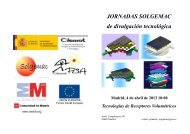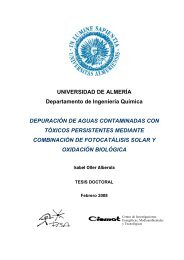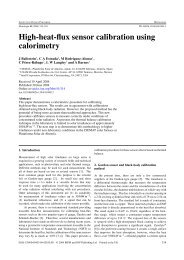Annual Report 2006 - Plataforma Solar de AlmerÃa
Annual Report 2006 - Plataforma Solar de AlmerÃa
Annual Report 2006 - Plataforma Solar de AlmerÃa
You also want an ePaper? Increase the reach of your titles
YUMPU automatically turns print PDFs into web optimized ePapers that Google loves.
PLATAFORMA SOLAR DE ALMERÍA<br />
reduction in hydrogen generation, because the oxygen separation stage for<br />
reuse of the inert gas would then not be necessary. The final goal is for the<br />
process temperature in the activation stage to be no higher than 1200 K, as<br />
the radiation loss increases with temperature by a power of four. TGA/DTA<br />
have shown that using nitrogen as the gas carrier, weight loss in the ferrites<br />
can be clearly attributed to partial reduction of magnetite. Weight loss and<br />
activation temperature increase when the Ni/Mn ratio <strong>de</strong>creases, being 0.5%<br />
to 700ºC and 2.57% at 900ºC for Ni/Mn=3 and 0, respectively Figure 3.25.<br />
Although in <strong>2006</strong>, hydrolysis testing with hydrogen production has still not<br />
been done, the results found in the activation stage (oxygen <strong>de</strong>sorption) have<br />
been very promising, with theoretical estimates leading to expect hydrogen<br />
production of around 1 to 3 mg H 2 /g ferrite in the water-splitting reaction.<br />
Publication: [3.28]<br />
<strong>Solar</strong> Hydrogen via Water Splitting in Advanced Monolithic<br />
Reactors for Future <strong>Solar</strong> Power Plants (Hydrosol-II).<br />
Participants:<br />
Contact:<br />
PSA Contact:<br />
Funding:<br />
APTL (GR), DLR (D), CIEMAT (E), STC (DK), Johnson Matthey<br />
(RU).<br />
Christos Agrafiotis; chrisagr@cperi.certh.gr<br />
Maria Jesús Marcos, mj.marcos@ciemat.es<br />
Cooperative project fun<strong>de</strong>d by the EC 6 th Framework Programme.<br />
Total budget: 4,230 k€. CIEMAT Budget: 647 k€.<br />
Duration: December 1, 2005 – December 1, 2009<br />
Motivation: <strong>Solar</strong> Thermochemical hydrogen production faces the great challenge<br />
of accomplishing solar concentrating technology and reactor scale-up to<br />
be able to operate at several MW power. Undoubtedly, this will be the central<br />
receiver technology, or the heliostat field with tower, which is the only one<br />
that can be adapted for this use. At the present time, there are <strong>de</strong>velopments,<br />
many of them tested jointly by the DLR and the CIEMAT at the PSA<br />
facilities, which allow volumetric receivers to operate at temperatures above<br />
1000ºC. The motivation for the Hydrosol-II project is the confi<strong>de</strong>nce in being<br />
able to transfer the experience accumulated in materials <strong>de</strong>velopment and<br />
systems with catalytic matrices using SiC with monolithic channels that were<br />
validated successfully during the SOLAIR project. The impregnation of these<br />
ceramic matrices with mixed ferrites will make it possible to use the volumetric<br />
of receiver/reactor concept for hydrogen production. The possibility of using<br />
this monolithic reactor with ferrites attached to a substrate greatly facilitates<br />
separation of oxygen from the hydrogen by using alternating charge and<br />
discharge stages.<br />
Purpose: The second phase of this project (Hydrosol-II) began in November<br />
2005, and its purpose is <strong>de</strong>monstration in a 100 kW reactor at the <strong>Plataforma</strong><br />
<strong>Solar</strong> <strong>de</strong> Almería of H 2 production from mixed Zn ferrites impregnated on SiC<br />
ceramic matrices. The innovation in this <strong>de</strong>sign is the use of an intermittent<br />
charge-discharge operating mo<strong>de</strong>. The endothermal stage is performed with<br />
solar illumination so the high-flux solar radiation in the focus generated by a<br />
heliostat field is moved alternately from some matrixes to others to allow the<br />
H 2 to be charged.<br />
The quantitative project goals are:<br />
62



